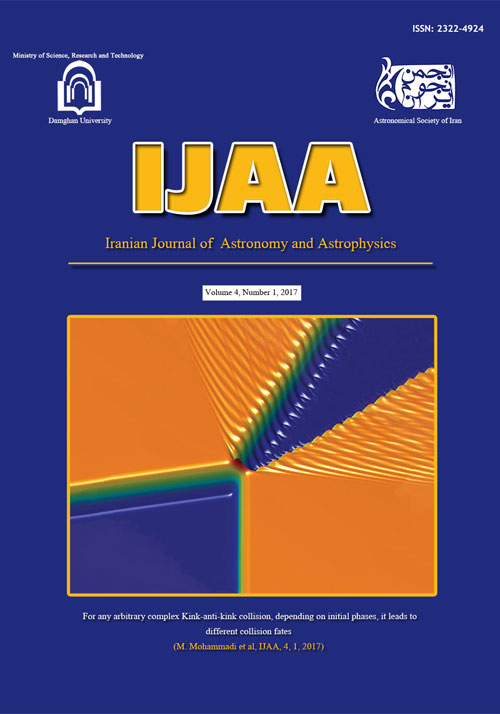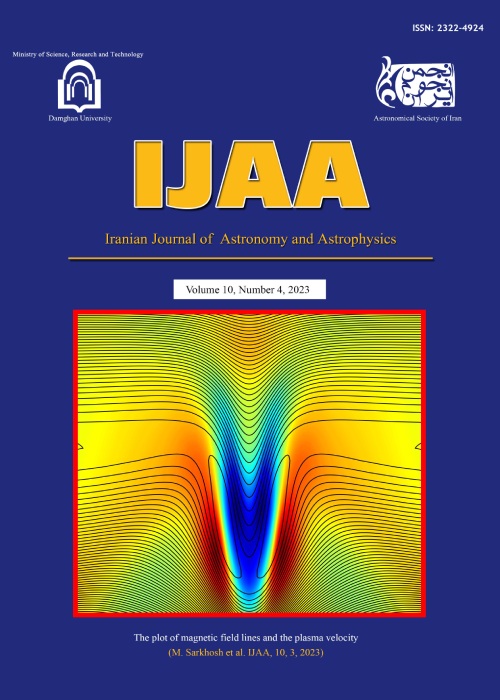فهرست مطالب

Iranian Journal of Astronomy and Astrophysic
Volume:4 Issue: 2, Autumn 2017
- ویژه نامه فارسی
- تاریخ انتشار: 1395/08/26
- تعداد عناوین: 10
-
-
صفحات 113-120
-
صفحات 121-137
-
Pages 69-78Air pollution is one of the most important problems in the worlds major cities in the last century because it endangers human health and the environment. One of the indicators of air pollution is nitrogen dioxide, which is continuously measured by satellite from space and via ground-based instruments. In this paper, the data for nitrogen dioxide was measured by OMI over Tehran. Wind, surface temperature and horizontal visibility were recorded at Mehrabad Meteorological Station during the period from October 2004 to May 2016 to evaluate the behavior and trends of air pollution. The average amount of nitrogen dioxide during the spring, summer, autumn and winter seasons were 6.99 ×1015, 6.22 ×1015, 16.90 ×1015, and 19.65 ×1015 molec/cm2 with the highest (lowest) value occurring in the winter (summer). Also, the highest (lowest) standard deviation occurred in the winter (summer), which was 14.84 ×1015 (3.73 ×1015). The correlation coefficient of nitrogen dioxide with wind and temperature were -0.04 and -0.59, respectively, which show a greater effect of temperature on nitrogen dioxide changes. Also, the correlation coefficient of nitrogen dioxide with horizontal visibility was -0.20, which indicates a reduction of horizontal visibility with increasing urban pollution in Tehran. The nitrogen dioxide trend was calculated using linear regression after eliminating four, six, and twelve-month periods with 95% confidence. The trend of nitrogen dioxide was 5.76 ×1014 molec/ cm2 per yearKeywords: Air Pollution, Nitrogen Dioxide, Trend, OMI sensor, Wind Surface Temperature, Horizontal Visibility, Tehran
-
Pages 79-95A partial decrease of the convective energy by the magnetic field of a sunspot causes the temperature of the magnetized plasma to decrease and this leads to a magneto-hydrostatic equilibrium. Thus, we expect a strong relation between magnetic field strength of a sunspot and its temperature/brightness. Here, we investigate this relation in the umbra of the large sunspot in NOAA10930 using spectro-polarimetric data recorded by Solar Optical Telescope on board Hinode. The magnetic field strength is measured by two Methods1) using the Stokes V profile of the neutral iron 630.25 nm line, and 2) running SIR inversion code on the full Stokes profiles of the two neutral iron 630.15 and 630.25 nm lines. The general behavior is the decreasing of magnetic field strength with temperature/intensity. For intensities less than about 0:2Iph (brightness temperature 4280 K; Iph is the mean photospheric intensity around the sunspot), decreasing magnetic field strength with increasing intensity has a steeper gradient, a power law function clearly explains the non-linear variations of magnetic field strength versus temperature/intensity. For intensities larger than 0:2Iph, at a given intensity, the range of the deviation of magnetic field strength is as large as 0.5 kG. By looking for the location of these points on the studied umbral region, we find that these points are belong to the inner penumbra where penumbral filaments intrude into the dark umbra at two corners of the studied umbral region which shows different magnetic field strengths. This difference can be due to the difference between the evolutionary stages of the penumbral filaments at the two corners during the observation period. For intensities less than 0:2Iph, the observed deviation around the power law behavior is partially due to the presence of umbral dots. Since umbral dots are brighter than the umbra, and the layers of optical depth unity are moved to higher heights, a smaller magnetic field strength may be measured in umbral dots. This causes the data points shift to larger intensities and smaller magnetic field strengths on the corresponding scatter plot. Since the increase in intensity and the decrease in magnetic field strength on different umbral dots are different, the scattering around the power law is explainedKeywords: The sun: sunspots, magnetic field
-
Pages 97-111In terms of observational data, there are some problems in the standard Big Bang cosmological model. Inflation era, early accelerated phase of the evolution of the universe, can successfully solve these problems. The inflation epoch can be explained by scalar inflaton field. The evolution of this field is presented by a non-linear differential equation. This equation is considered in FLRW model. In FLRW model, we consider the universe as the warped product of real line with a three dimensional homogeneous and isotropic manifold _ which could have positive, negative or zero curvature. The main aim of this paper is the numerical solution of the inflation evolution differential equations using of a meshless discrete Galerkin method. The method reduces the solution of these types of differential equations to the solution of Volterra integral equations of the second kind. Therefore, we solve these integral equations using moving least squares method. Finally, a numerical example is included to show the validity and efficiency of the new techniqueKeywords: Big Bang, Inflation, Lorentzian manifold, Meshless Method, Moving least squares
-
Pages 113-120Heat transfer by electromagnetic radiation is one of the common methods of energy transfer between objects. Using the fluctuation-dissipation theorem, we have studied the effect of particle arrangement in the transmission of radiative heat in many-body systems. In order to show the effect of the structure morphology on the collective properties, the radiative heat transfer is studied and the results are compared for fractal and periodic structures. The calculations for fractals are restricted to the fractal structures based on vicsek model. It is shown that the thermal conductance can be large even for far apart particles in periodic structures. In contrast, it is shown that fractal arranged nanoparticles display complex radiative behavior related to their scaling properties, and heat flux is not of large-range character in such structuresKeywords: many, body effects, radiative transfer, nano, structures, dipole, fractal
-
Pages 121-137cluster are responsible for the peculiar motion; however the exact source of the peculiar motion is still uncertain and it seems that this motion and other types of anisotropies in large scales have a common source. The chameleon fields can be a good candid to explain both types of anisotropy, namely the bulk flow in small scales and other types of anisotropies in large scales. In this paper, we study the bulk in the presence of chameleon fields flow in different scales. While in the past, this has been studied mostly using galaxies as distance indicators, the weight of type Ia supernovae (SNe Ia) has increased recently. We use Union2 catalogue containing 557 type Ia supernovae (SNe Ia) in redshift range, 0٫ 15Keywords: Camelon: bulk flow, supernova, distance modulus
-
Pages 139-149Level 2 data of Caliop space-borne lidar is used during 2006-2017 for 144 night overpass of Calipso satellite over Zanjan. It is seen that aerosol optical depth is increased during spring and summer. For example, maximum/minimum monthly-averaged AOD is 0.36/0.06 for August/December. The particulate depolarization ratio of data shows that dust is the dominant aerosol in the atmosphere of Zanjan. There is no relationship between AOD and surface wind speed. Also, based on the results of HYSPLIT backward trajectory model, the Tigris-Euphrates basin is the main dust source of the atmosphere of Zanjan. The parameter of horizontal visibility is not sharply decreased during dust events and it is accompanied by higher altitudes of recorded dust layers and therefore, one can conclude that dust particles have mainly external sourcesKeywords: Calipso satellite, Caliop space, borne lidar, aerosol, dust, depolarization ratio, aerosol optical depth, dust layer, Zanjan
-
Pages 151-159The fluid description is employed to investigate the instability of Newtonian viscous shear dusty plasma system in hydrodynamic regime, taking into account both viscosity and collision effects. Describing the equilibrium configuration in the presence of the binary collision terms between dust grains and neutral particles and using the local approximation method, the dispersion relation is obtained by applying the generalized hydrodynamic equation to find the spatial dependence of the initial velocity in equilibrium state. Analyzing the obtained dispersion relation shows that the main factor of free energy source to arise the instability of the system is due to the viscous force. While the collision effect plays a stabilizing role for the system by reducing the growth rate of the instability of the Newtonian strongly coupled dusty plasma system in the hydrodynamic regime.Keywords: Shear dusty plasma: strongly coupled: viscosity: collision: instability
-
Pages 161-170Results of a study on tropospheric NO2 over Iran for a 14 years period have been reported. Monthly averages of tropospheric NO2 concentrations recorded by OMI from Oct 2004 to Mar 2018 have been used. A model including a linear and sinusoidal term is applied to study trend and seasonal behavior of NO2 concentrations. Original 0.125 ×0.125 degree data of OMI have been averaged to get 1 ×1 degree resolution to analyze trends. Trend results with 95% confidence level have been reported. In 27 centers of provinces in Iran, real trends have been detected. By using seasonal analysis, mostly polluted months have been determined for these cities. 2 cities experience most pollution in spring, 3 in summer, 2 in autumn and 24 cities in winter. Pollution source type classification shows 24 urban and 3 soil emission cases for the studied cities. Source type determination was impossible in 4 cities by criteria used in this paper.Keywords: NO2, Iran, OMI, Trend, Seasonality, Source Type
-
Pages 171-182In this work, we consider the type I Bianchi model in a fractal cosmology and investigate the ghost dark energy model from the statefinder viewpoint. The statefinder diagrams depict the properties of the ghost dark energy and show the discrimination between this scenario, ΛCDM and generalized ghost dark energy models. By using the statefinder parameters r and s, we find out that the studied model can attain the ΛCDM phase of the fractal universe. We also show the behavior of the ghost (generalized ghost) dark energy and quintessence (phantom). Lastly, we show the effect of the anisotropy on the evolution of the universe in the statefinder diagram.Keywords: Anisotropic universe, Fractal cosmology, Ghost DE, Generalized ghost DE, Statefinder diagram
-
Pages 183-194Recently, the longitudinal oscillations of intensity have been frequently detected in the different structures of the solar corona using space telescope observations. Some researchers believe that the magneto-acoustic waves, which share the plasma heating processes in the corona, are responsible for the longitudinal oscillations of the intensities. In this study, the aim is to discover the location, generation, propagation and damping of the magneto-acoustic waves in the corona structures as well as to compare the results with theoretical models. For this purpose, for each selected active region, about 400 sequence images are taken at 12 seconds intervals at 171 angstroms using AIA instrument onboard on the SDO space telescope. For each set, the histogram equalization is applied with respect to the first image for all images, then the time series of intensities are extracted from the successive macropixels with 3×3 pixels wide on different paths along the active region loops. Different filters are applied to the time series of the intensities, and real and stable frequencies are identified from the unrealistic and unstable frequencies of the noise in the spectral power density using the Lamb-Scargle algorithm. The physical quantities of the dominant frequencies are computed. The results of this analysis showed that magneto- acoustic waves are produced at the base of the loops of the active regions and propagated along the loops. The range of oscillation period, apparent velocity, apparent length, damping time, and damping quality of these extracted waves are 7-32 minutes, 66-363 km/s; 8-103 mega meters, 0.7-12 minutes and 0.06-0.63, respectively. Also, by comparing the observational results with the theoretical models, the temperature range and electron numerical density of the selected regions are estimated.Keywords: Sun: corona. Sun: active region. Sun: longitudinal intensity oscillations


